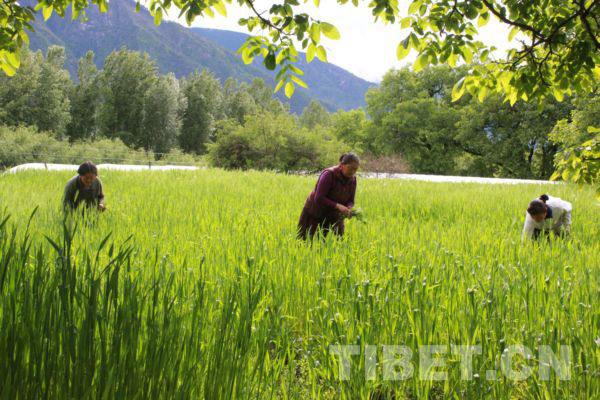Tibet's grain industry maintains sustainable development
Updated: 2013-10-22 13:46
(China Tibet Online)
|
|||||||||||
Themed as "Sustainable Food Systems for Food Security and Nutrition", the World Food Day in 2013 falls on Oct 16. Tibet has embraced the harvest since September and its grain industry maintains a sustainable development and ensures safety in production. The Shigatse prefecture, renowned as the "granary of Tibet", has celebrated its highland barley harvest by the side of Nyangchu River in the fall of 2013.
Tendar, an old man lived in the Pelek Village of Lhatse Township, which belongs to the Lhatse County of Shigatse Prefecture, said: "There are 11 people in my family and we own 41.5 mus of farmland. The main food crops are highland barley, winter wheat and oilseed rape." According to Tendar's estimates, the total amount of highland barley harvest will reach more than 15,000kg. If every kilogram of highland barley is worth 3.6 yuan (about 0.59 U.S. dollars), then the Tendar's family can make a profit of over 50,000 yuan (about 8200 U.S. dollars) this year.
"A bumper year again," said Tendar, "every year the government will distribute the grain subsidy directly to us, which greatly improves our farmers' motivation."
According to the official data, by the end of 2012, the amount of annual Tibetan food production has maintained over 900,000 tons for 13 consecutive years, thereinto, the annual output of highland barley has kept stabilized around 600,000 tons.
Related Stories
Food security concerns despite bumper harvest 2013-10-16 14:13
Cafe Noir hosts Singapore food festival 2013-10-14 16:29
Food for sharing 2013-10-13 08:27
China finds 311 batches of bad imported food 2013-09-30 10:09
GM foods make its way to China market 2013-09-29 10:49
Today's Top News
UK official looks to China for support
Economy to see 'good ending' in Q4
Teacher killed in US school shooting
Border agreement to boost ties
US OKs Alibaba structure
Beijing works to spur global development
Scientists requested government to plant GM crops
Travelers to Europe bypass attractions of Brussels
Hot Topics
Lunar probe , China growth forecasts, Emission rules get tougher, China seen through 'colored lens', International board,
Editor's Picks

|

|

|

|

|

|






